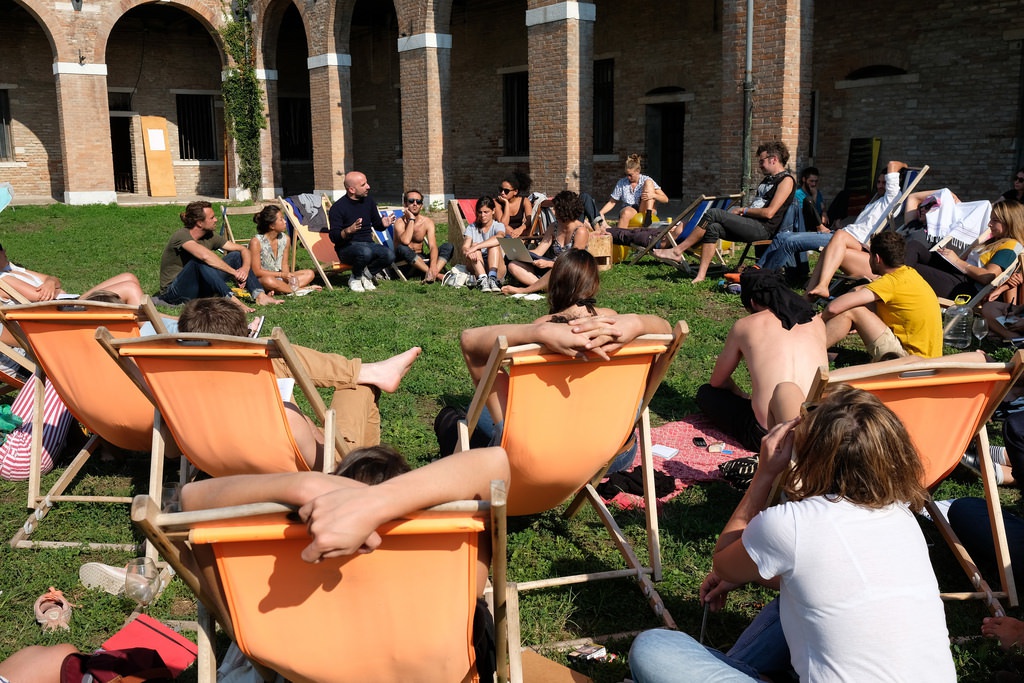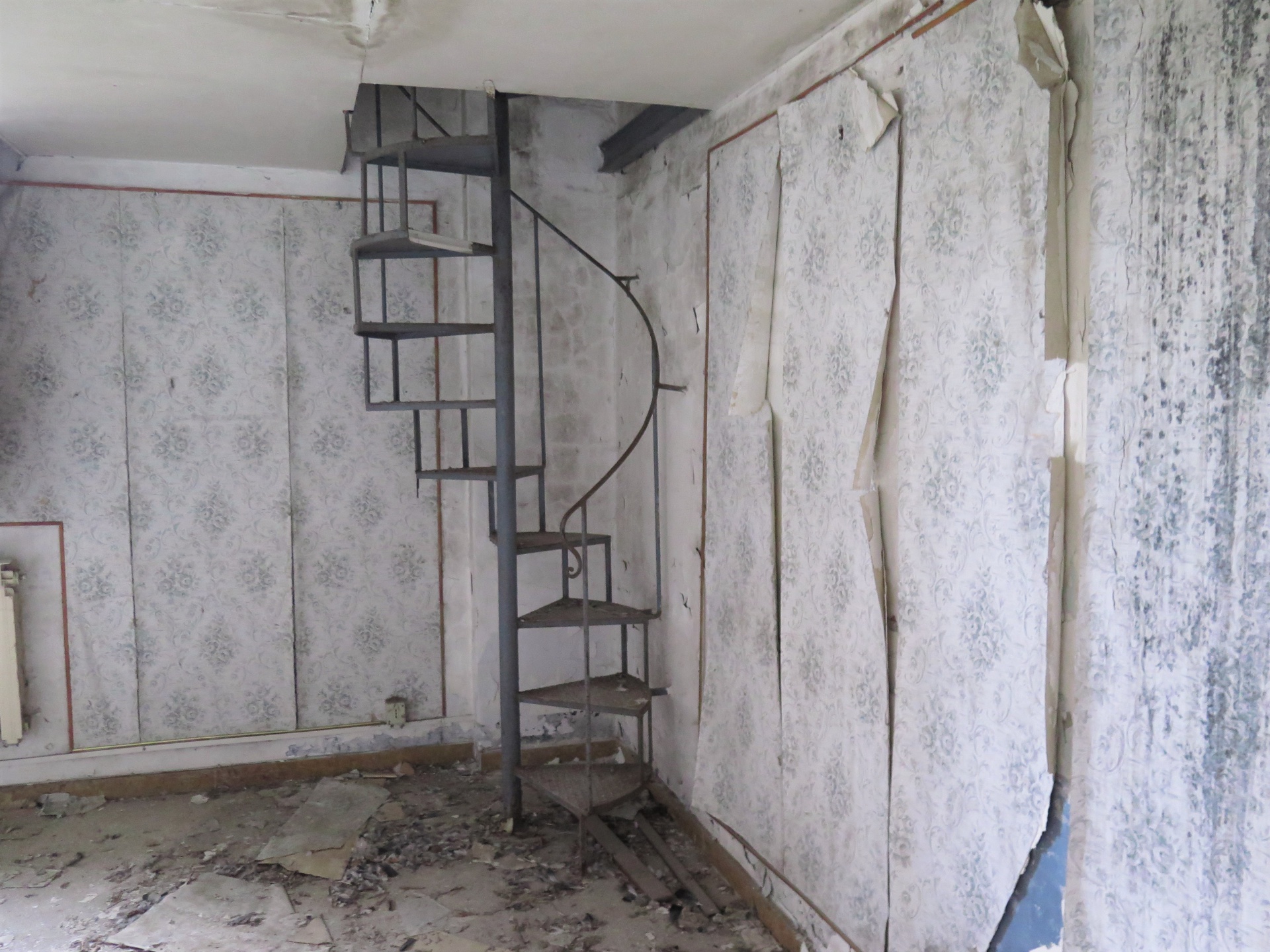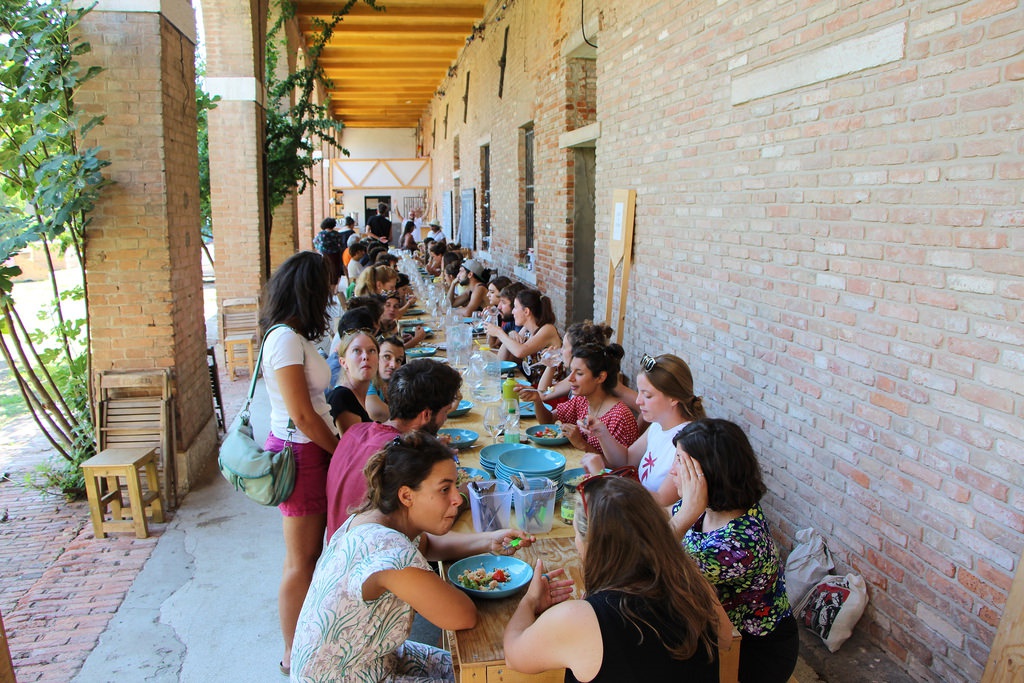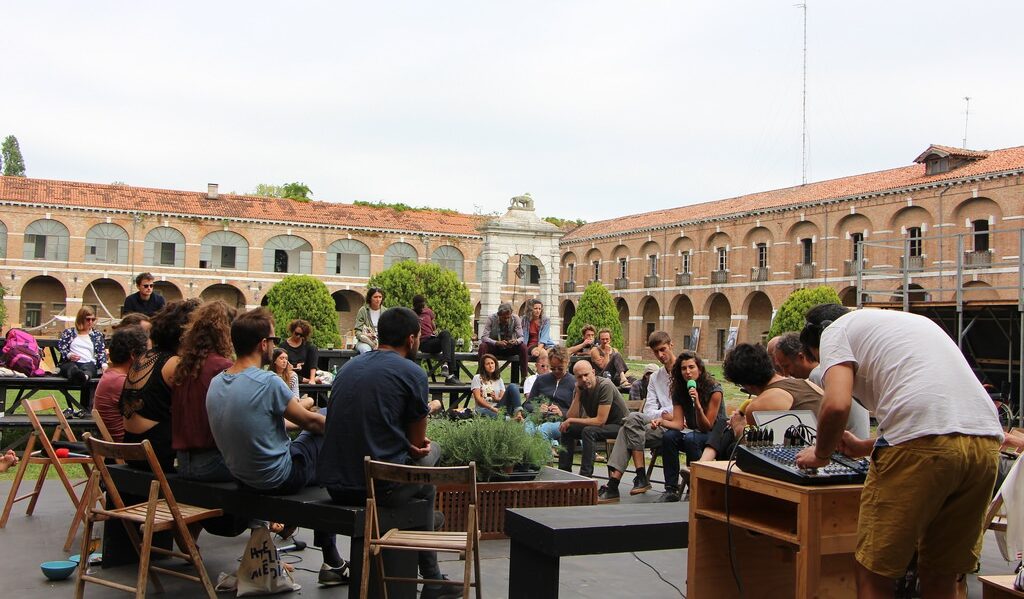我拽著行李箱上岸,按腦海裡的地圖印象,打算沿著麗都島(Lido)的狹長海岸一直往前行,若看見島上北邊的機場便會找到Esperienza Pepe(簡稱Pepe)入口才是。大門被鍊條拴住,乍看人煙杳杳,電話一接通我便慌亂地解釋我是誰、我有住房預約、正確的入口不知道是否在此、我被鎖在門外……對方一頭霧水要我別急,慢慢說:「啊,你要密碼是吧!」「對!對!」「密碼是……」
來到Pepe,只要好好說明來意,哪怕只是一窺究竟的好奇心,也能獲得通關密碼,沒有人會被拒於門外,不需緊張如我才是。
 Pepe草地上色彩鮮艷的休閒躺椅是大家聚集與討論的場所。圖/Yes We Camp提供
Pepe草地上色彩鮮艷的休閒躺椅是大家聚集與討論的場所。圖/Yes We Camp提供
Pepe前身為Guglielmo Pepe軍營,建於1591至1595年間,軍事活動止於1999年,該處也因此沒落。直至2016年,Biennale Urbana(BURB)1來到這個軍營舊址舉辦「介入城市工作坊」(Urban Intervention Camp)的短期計畫,串連島上或島外的夥伴共同舉辦文化活動,活化此地。今年BURB獲得Pepe一年進駐管理使用權限,遂邀請Encore Heureux建築師事務所2以「無限之所」(Infinite Places)計畫來協助規劃;此計畫與旗下的關係團體用社會新創的方法重建場域,希望提供大眾獨特的文化體驗,並開放跨域的專業者進駐這裡。Pepe的歷史背景與再開放的目標近似於前身為空軍總司令部的臺灣當代文化實驗場(C-LAB),初心在於打開一個獨斷權威的封閉場域,向在地與國際的公眾開放。作為一個將行動付諸實踐的現場,有來自法國與義大利兩方的改造者參與,可謂同時具研究性質與實踐動能的限地計畫,相當於C-LAB極佳的海外參照點,也因此吸引在C-LAB工作的筆者入場觀察。
通過唯一的弧頂入口,方正回型建築體所圈住的,是得以遠離威尼斯商業觀光外自成一格的園區,剝落的磚瓦顯出陳舊建築的年份。樓高不過二層,其上一排玻璃窗破碎處長出攀牆植物,草地上散落鮮黃色的彈力球和幾把鮮豔的休閒躺椅,通透挑高的一樓廊道垂掛一條條米白色的吊床,一雙手臂露出捧著書表示有人正沉浸在午後的閱讀,破敗與新生的氣息雜揉,當刻有點閒懶,但你看得出來他們只是在醞釀下一場的騷動,有股活力自由川流其中。
自從了解Pepe的背景之後,我一直期待探查每一處角落,尤其經過七年雜草蔓生的荒蕪,要如何快速開放場域,以文化行動催生新型態的社群?在前台登記入住並聽完設施簡介後,我放下行李就直往看似破敗的二樓走。「無限之所」計畫是立基於建築場域與建築學相關之參照研究,來發展綜整藝術、文化、社會交往的項目行動。這些聚焦前瞻思考的場域計畫重視集眾思考的過程,共同建構社群經驗,它們的特性在於有彈性地開放創造建築本體與場所之間的自由空間,尋求開發活化的各式替代方案。在短短不到一年的時間內,「無限之所」計畫團隊整理與開放了哪些空間?又有哪些尚未準備好對大眾開放的區域?這兩者間如何選擇與區隔?攜著滿腦子的疑問,我往二樓走去,門又給密碼鎖的鍊子圈上,紙條寫著「這一扇門並不會讓你通往天堂」,如此柔性的勸導惹人發笑,我下樓再度向人詢問通關密碼。
「你想上去看嗎?可以啊,但要做好心理準備,你可能什麼都會看到!」
「像是……?」
「所有你想像得到與想像不到的!」這句話讓我滿腹疑惑。
「總之,小心再小心,留心步伐,好嗎?」
不過這麼簡單的一種信任機制,叮嚀提醒,然後放行。
 Pepe二樓的廢墟空間像1999年後某個斷裂時間點的切片。圖/楊志雅攝影
Pepe二樓的廢墟空間像1999年後某個斷裂時間點的切片。圖/楊志雅攝影
 Pepe二樓的廢墟空間像1999年後某個斷裂時間點的切片。圖/楊志雅攝影
Pepe二樓的廢墟空間像1999年後某個斷裂時間點的切片。圖/楊志雅攝影
燈罩從天花板塌落,幾乎沒有一扇完整的門或窗,百葉簾和碎玻璃散落一地,壁紙從牆上膨凸掀起,走沒幾步路就會有鴿子被我的腳步聲嚇著,從坍陷的屋頂縫隙唰地飛出,地上滿是羽毛,偶而有幾具乾癟的鴿屍像是被人刻意擺陣一般躺在空蕩的迴廊,一陣風吹過,代替門的布簾掀動。如果說Pepe一樓經過活化的空間像是一具剛裝上電池重新轉動的鐘,二樓則是鉗住1999年某個斷裂時間點的切片,凝滯不動,像極了C-LAB園區裏那一幢舊辦公大樓的古蹟建物。
這趟以外部參與者的眼光進入他方場域探查,令我反覆思考的是,在理解(無論或深或淺)空間正處於動態的轉型過程,面臨眼前這般頹喪待舉的樓層,外部參與者是否會對營運單位產生負面印象?是否挑剔營運團隊修繕得不夠努力和快速?何不整頓好整體營區再一起對外開放,甚至連帶否定那些已經活用的空間未臻完善?換個方式思考,目前不同樓層間活化進度不一的對比差異,反而可以幫助觀者了解空間轉型的時序脈絡:從荒廢停滯、熱身、分階段活化,再到面向觀眾開放等。
空間的轉型過程當中是否應容許嘗試錯誤和討論的餘地,在營運磨合間是否能保有階段性的目標?
Pepe恰是聚結數個團體的智慧結晶,包含前述所提的Encore Heureux建築團隊,與其「無限之所」計畫項下十個關係團體,負責空間改造者尚有Yes We Camp,是主要駐點於巴黎和馬賽的社會創新組織,擅以藝術人文手法為廢棄荒地注入活力,翻轉城市空間。Yes We Camp今年也來到C-LAB以創作移動式戶外家具的工作坊和封閉的園區互動。
Pepe裡的每項決議都是經由眾方討論,不僅是營運方,就連各地到來的志工,皆可提出意見回饋。我入住時期遇見的Vu和Oh,是正值暑假從法國來打工換宿的大學生,某天早上他們整理完環境邀我去附近海灘躺一個上午,我們漫天談論各式點子,他們說要整理在吧台後方的某個小空間,想在裡頭搭個簡易的木書架,這樣島民或者入住者就可以自由捐獻或交換書籍,在Pepe裡享受閱讀時光。我說,在臺灣為了因應像麗都島,近水郊區蚊蟲惱人入眠的狀況,我們使用蚊帳,以Pepe團隊可以搭建出木造床架的能力,只要找到合適的紗網材質,應能做出有防蚊功能的床幔紗帳。不論這個想法後續是否真有機會被實踐,至少你知道,任何踏進Pepe場域的人,都可以放心拋出或大或小的點子,任想法激盪,各種放鬆討論之下可被成形的需求設置,皆可能是吸引民眾走入廢棄場域的突破關鍵。
 Pepe的大餐桌是聚集各路人馬的交際場,大家在此交換對場域轉型的想像。 圖/Yes We Camp提供
Pepe的大餐桌是聚集各路人馬的交際場,大家在此交換對場域轉型的想像。 圖/Yes We Camp提供
於是,每個人皆能在Pepe裡面找到舒適的角落。例如拎著啤酒到木板桌台玩起乒乓球的哥倆好、在U型池練著特技的滑板青年、聚在投影幕前為世足賽瘋狂的法國參訪團體、細心纏繞紙條於枝椏間,為晚間藝術體驗做準備的藝術創作者,大家都為了自己興趣愛好而忙碌。晚上八點一到,人群從各角落冒出頭來,紛紛坐在大餐桌前,分享白日的各種收穫和體驗,不知誰變出一把吉他開始刷唱,讓這個社交場隨之有節奏地歡快了起來。長桌的另一頭傳來小小的騷動,有位訪客對晚餐不甚滿意憤而離席,讓這幾個月以來每天帶領伙伴費心張羅晚餐的Jul難掩失落,解釋這是頭一遭有訪客以專業餐廳的標準來評價這裡的餐點,儘管她極力說明這裡並非是純粹提供餐飲服務的戶外餐廳,也非一間客棧,而是一處以各種混融形式促進民眾參與的社交場,餐點也許並非最精緻,但重點在於歡迎到來的每一位,不論是走進廚房協助備料、幫忙餐桌擺設,或是在餐桌旁與其他訪客聊上一夜,交換對場域的轉型想像,讓人與場域之間的關係並非固化而有彈性,這才是Pepe空間轉型的目的。大家笑著過去輕摟著她,紛紛與她碰杯說「沒有關係」「餐點很豐盛哪」「他不能再多聊聊真是可惜」!
今年第16屆威尼斯建築雙年展的核心概念為「自由空間」(Freespace),宣言裡提及自由空間期建立一種範式,旨在揭露現下建築普遍存有實質意義或概念上的缺失,要使建築能夠成為一個介面,歡迎人們表達自由的意志,喚醒公眾意識,並召喚人心原有的慷慨分享本性,使公眾能夠漸進式地參與對於建築存在核心意義之討論。如同那位未被餐飲服務滿足轉身離去的訪客,也許因此會對空間的多重功能進一步思索,為何這裡並不是單純提供美食服務的場域,看起來也非功能完整的藝廊,更不似整潔如新的青年旅社,好像有事情在這裡發生,有人氣在此處聚集,可是要如何定義這種複合功能的建築,與其變動不固定的空間使用方式?此或可引發人們向內詰問,訓練和轉化其自由意志。
 空間轉型需要時間試錯,這個過程勢必納入公眾參與和討論。 圖/Yes We Camp提供
空間轉型需要時間試錯,這個過程勢必納入公眾參與和討論。 圖/Yes We Camp提供
際此,試想一種帶有實驗精神、與眾俱進的空間發展進程,保有階段性的試探和轉折,在難以定義之時,或許更具使用上的彈性,以趨近多樣化的人性需求。營運方也能消化過往時間之於建築本體造成的凋敝,擱下不安或羞於示眾,讓尚未來得及完成修繕或功能仍未定型的場域,作為時間移動軌跡的鋪陳,觀者可從中獲得更多與發展脈絡有關的理解與想像。至於重新介入空間的改造方,則可試圖說服公眾,空間轉型需要時間試錯,而這些過程勢必納入公眾的參與和討論,否將落入菁英改造空間的窠臼。
正如場域的凋敝需要時間,而它的復甦也是,公眾的討論參與可能費時,不過從來聚眾集智的過程難以速成,我們對於場域轉型或許不該抱持一步到位的不切實際期待,也不好過度預設公眾的耐心有限。假若,這是開放每個人都可以平行加入的遊戲機制,人們可以自由的提供意見和自在的付出智識或勞力,一種共生環境和共造的氛圍也將油然而生。
離開Pepe的前夕,年輕的藝術創作者從二樓碎玻璃滿地的走道上,輕輕拾起那一具乾癟的鴿屍,在一樓點起蠟燭,佈置了一個類似祭壇的空間,兩個人在旁邊輕聲朗誦詩,作品意圖不夠明確也不夠強烈,但是這天來到營區的大家都投入觀賞這個初試啼聲的小型藝術展演。過程之於一場實驗很是關鍵,不是直至尾聲交出完滿精美的成品,才算是實驗成果,開放期待的過程或許才是最大體現並觸及實驗的核心精神,常常我們都太執著於以完美的姿態示人,忘了過程中眾人之間的接觸、碰撞和靈光一瞬,有時更是動人。